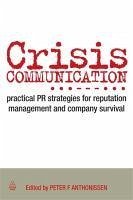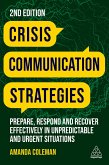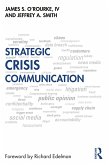Crisis Communication (eBook, ePUB)
Practical PR Strategies for Reputation Management
Redaktion: Anthonissen, Peter


Alle Infos zum eBook verschenken

Crisis Communication (eBook, ePUB)
Practical PR Strategies for Reputation Management
Redaktion: Anthonissen, Peter
- Format: ePub
- Merkliste
- Auf die Merkliste
- Bewerten Bewerten
- Teilen
- Produkt teilen
- Produkterinnerung
- Produkterinnerung

Hier können Sie sich einloggen

Bitte loggen Sie sich zunächst in Ihr Kundenkonto ein oder registrieren Sie sich bei bücher.de, um das eBook-Abo tolino select nutzen zu können.
No company or organization is immune to crisis. A crisis, however, does not necessarily have to turn into a PR disaster. Crisis Communications provides readers with advice on how to limit damage by acting quickly and positively. Moreover, it explains how to turn a crisis into an opportunity by communicating efficiently via a successful public relations strategy.
Crisis Communications is a thorough guide to help prepare an organization for unexpected calamities. It provides information on accountability, planning, building corporate image, natural disasters, accidents, financial…mehr
- Geräte: eReader
- mit Kopierschutz
- eBook Hilfe
- Größe: 1.33MB
- FamilySharing(5)
![Crisis Communication (eBook, ePUB) Crisis Communication (eBook, ePUB)]() Audra Diers-LawsonCrisis Communication (eBook, ePUB)41,95 €
Audra Diers-LawsonCrisis Communication (eBook, ePUB)41,95 €![Crisis Communication Strategies (eBook, ePUB) Crisis Communication Strategies (eBook, ePUB)]() Amanda ColemanCrisis Communication Strategies (eBook, ePUB)25,95 €
Amanda ColemanCrisis Communication Strategies (eBook, ePUB)25,95 €![Communicate in a Crisis (eBook, ePUB) Communicate in a Crisis (eBook, ePUB)]() Kate HartleyCommunicate in a Crisis (eBook, ePUB)25,95 €
Kate HartleyCommunicate in a Crisis (eBook, ePUB)25,95 €![Ethical Voices (eBook, ePUB) Ethical Voices (eBook, ePUB)]() Mark W. McClennanEthical Voices (eBook, ePUB)10,95 €
Mark W. McClennanEthical Voices (eBook, ePUB)10,95 €![Organizational Crisis Communication (eBook, ePUB) Organizational Crisis Communication (eBook, ePUB)]() Finn FrandsenOrganizational Crisis Communication (eBook, ePUB)60,95 €
Finn FrandsenOrganizational Crisis Communication (eBook, ePUB)60,95 €![Strategic Crisis Communication (eBook, ePUB) Strategic Crisis Communication (eBook, ePUB)]() James O'RourkeStrategic Crisis Communication (eBook, ePUB)33,95 €
James O'RourkeStrategic Crisis Communication (eBook, ePUB)33,95 €![Myths of PR (eBook, ePUB) Myths of PR (eBook, ePUB)]() Rich LeighMyths of PR (eBook, ePUB)15,95 €
Rich LeighMyths of PR (eBook, ePUB)15,95 €-
-
-
No company or organization is immune to crisis. A crisis, however, does not necessarily have to turn into a PR disaster. Crisis Communications provides readers with advice on how to limit damage by acting quickly and positively. Moreover, it explains how to turn a crisis into an opportunity by communicating efficiently via a successful public relations strategy.
Crisis Communications is a thorough guide to help prepare an organization for unexpected calamities. It provides information on accountability, planning, building corporate image, natural disasters, accidents, financial crises, legal issues, corporate re-organization, food crises, negative press, media training and risk managers.
Contributors include: Kathryn Blanchard (USA); Roger Bridgeman (USA); Willem Buitelaar (The Netherlands); Marianne de Bruijn (The Netherlands); Tom Gable (USA); Kathryn H Tunheim (USA); Jerry Hendin (USA); Stuart Hyslop (United Kingdom); Nick Leighton (United Arab Emirates); Thom M Serafin (USA); Bob Oltmanns (USA); Steven Pellegrino (USA); Silvia Pendas de Cassina (Mexico); Nuria Sanchez (Spain); Elizabeth Seigenthaler Courtney (USA); Tony Shelton (USA); Odile Vernier (France); Jim Walsh (Ireland); Tim Wallace (USA); Mania Xenou (Greece).
- Produktdetails
- Verlag: Kogan Page eBook
- Seitenzahl: 240
- Erscheinungstermin: 3. September 2008
- Englisch
- ISBN-13: 9780749455538
- Artikelnr.: 38218166
- Verlag: Kogan Page eBook
- Seitenzahl: 240
- Erscheinungstermin: 3. September 2008
- Englisch
- ISBN-13: 9780749455538
- Artikelnr.: 38218166
- Herstellerkennzeichnung Die Herstellerinformationen sind derzeit nicht verfügbar.
There are no guarantees
Stakeholders are everywhere
The accountability factor
Annoying threats
Crises are challenges
Successful crisis communication -- principles
Learn lessons from what has happened
A crisis for every day of the week
Conclusion 2. Proactive Crisis Communication Planning Nick Leighton and Tony Shelton Introduction
Need for a plan
What is a crisis?
What a crisis plan provides
Elements of a plan
People
The plan
Conclusion 3. Image as a Part of Corporate Strategy Tom Gable Introduction
Reputations add value over time
Determining how you want to be known
Establishing competitive advantage
Communicating what you stand for
Planning to reach all potential audiences
Turning vision into reality
Tell real stories
Appeal to higher standards, bigger ideas
Conclusion 4. Calamities Jerry Hendin, Silvia Pendás and Jim Walsh Introduction
Aeroplane accidents
Natural disasters
Being prepared: Alaska Airlines 261
When fire strikes -- twice
Conclusion 5. The New Dynamics of Financial Crisis Tim Wallace Introduction
Understanding financial crisis
Institutional investors: potential agents of crisis
Responding to financial crisis
Conclusion 6. Fraud Thom M Serafin Introduction
Gather the facts
Legal issues must be sorted out
Third-party validation
Delay and denial compound the problem
When your client is a victim of fraud
Implementing an action plan
Conclusion 7. Reorganization and Restructuring Kathryn Tunheim, Marianne de Bruijn and Jim Walsh Introduction
Swiss purchase of US financial services company
Moving business from The Netherlands to Germany
Goodwill is vital in a closure situation
Conclusion 8. A Multitude of Challenges for the International Food Sector Mania Xenou Food safety
Health and diet issues
Crisis preparation is the key to success
Stakeholders
The need for proactive communication
The media
Conclusion
Case study 9. Negative Press and How to Deal with It Elizabeth Seigenthaler Courtney Introduction
Prepare early and often
Mitigate impact with proactive response
Detecting a negative story before it appears
No ostriches need apply
Building bridges toward recovery
Conclusion
Case study 10. There is No Substitute for Media Training Nick Leighton, Steven Pellegrino and Tony Shelton Introduction
Who should we train?
Who should do the training?
Other resources
Who are the media?
Developing the crisis message
Know the rules of the game
Conducting the training
Conclusion 11. How Senior Management Can Make the Crisis Worse Stuart Hyslop Introduction
How it can all go wrong
Managing to make it worse
Getting it right
How to demonstrate leadership
Avoidance is endemic
The danger signs
Conclusion 12. Judgement Days Kathryn Tunheim Introduction
Case study
Conclusion 13. Environmental Crisis Communications Robert J Oltmanns Introduction
Laying the groundwork: creating a culture of environmental stewardship
When a crisis hits
Conclusion 14. Crisis Communication and the Net Roger Bridgeman Introduction
The nature of the net... fast, expansive, inclusive and a great leveller
New medium, new risks
The power to empower a crisis
New tools, new opportunities
The new ground rules
Crisis communications -- engagement versus pronouncements
Conclusion 15. Organizational Barriers to Crisis and Public Affairs Management Roger Bridgeman Introduction
Dismissing the issue, marginalizing the opposition
Averting a crisis by early action
Corporate resources can't trump a crisis
Responding to a crisis with real process change
Assuming a quick fix will make the problem go away
Confusing facts with perception
Combating the corporate siege mentality
Conclusion 16. Risk Managers Odile Vernier Introduction
When brands do not measure up to public opinion
'Social autism'
Turning public opinion into an asset
The brand -- its financial and social implications
Risks, risk managers and crisis communication
Company governance: a new source of crises
Conclusion 17. Crisis Communication Checklists Peter Frans Anthonissen 1. Preparations
2. Public groups and stakeholders
3. Crisis centre
4. What's in your crisis-communication survival kit?
5. Background information
6. Employee training: dealing with the media
7. Crisis manual
8. How to handle a crisis
9. Crisis strategy
10. Crisis communication Appendices 1. Factual Information Document 2. Message Development Document 3. Crisis Preparation Document 4. Special Considerations for Dealing with Reporters in a Crisis Bibliography
There are no guarantees
Stakeholders are everywhere
The accountability factor
Annoying threats
Crises are challenges
Successful crisis communication -- principles
Learn lessons from what has happened
A crisis for every day of the week
Conclusion 2. Proactive Crisis Communication Planning Nick Leighton and Tony Shelton Introduction
Need for a plan
What is a crisis?
What a crisis plan provides
Elements of a plan
People
The plan
Conclusion 3. Image as a Part of Corporate Strategy Tom Gable Introduction
Reputations add value over time
Determining how you want to be known
Establishing competitive advantage
Communicating what you stand for
Planning to reach all potential audiences
Turning vision into reality
Tell real stories
Appeal to higher standards, bigger ideas
Conclusion 4. Calamities Jerry Hendin, Silvia Pendás and Jim Walsh Introduction
Aeroplane accidents
Natural disasters
Being prepared: Alaska Airlines 261
When fire strikes -- twice
Conclusion 5. The New Dynamics of Financial Crisis Tim Wallace Introduction
Understanding financial crisis
Institutional investors: potential agents of crisis
Responding to financial crisis
Conclusion 6. Fraud Thom M Serafin Introduction
Gather the facts
Legal issues must be sorted out
Third-party validation
Delay and denial compound the problem
When your client is a victim of fraud
Implementing an action plan
Conclusion 7. Reorganization and Restructuring Kathryn Tunheim, Marianne de Bruijn and Jim Walsh Introduction
Swiss purchase of US financial services company
Moving business from The Netherlands to Germany
Goodwill is vital in a closure situation
Conclusion 8. A Multitude of Challenges for the International Food Sector Mania Xenou Food safety
Health and diet issues
Crisis preparation is the key to success
Stakeholders
The need for proactive communication
The media
Conclusion
Case study 9. Negative Press and How to Deal with It Elizabeth Seigenthaler Courtney Introduction
Prepare early and often
Mitigate impact with proactive response
Detecting a negative story before it appears
No ostriches need apply
Building bridges toward recovery
Conclusion
Case study 10. There is No Substitute for Media Training Nick Leighton, Steven Pellegrino and Tony Shelton Introduction
Who should we train?
Who should do the training?
Other resources
Who are the media?
Developing the crisis message
Know the rules of the game
Conducting the training
Conclusion 11. How Senior Management Can Make the Crisis Worse Stuart Hyslop Introduction
How it can all go wrong
Managing to make it worse
Getting it right
How to demonstrate leadership
Avoidance is endemic
The danger signs
Conclusion 12. Judgement Days Kathryn Tunheim Introduction
Case study
Conclusion 13. Environmental Crisis Communications Robert J Oltmanns Introduction
Laying the groundwork: creating a culture of environmental stewardship
When a crisis hits
Conclusion 14. Crisis Communication and the Net Roger Bridgeman Introduction
The nature of the net... fast, expansive, inclusive and a great leveller
New medium, new risks
The power to empower a crisis
New tools, new opportunities
The new ground rules
Crisis communications -- engagement versus pronouncements
Conclusion 15. Organizational Barriers to Crisis and Public Affairs Management Roger Bridgeman Introduction
Dismissing the issue, marginalizing the opposition
Averting a crisis by early action
Corporate resources can't trump a crisis
Responding to a crisis with real process change
Assuming a quick fix will make the problem go away
Confusing facts with perception
Combating the corporate siege mentality
Conclusion 16. Risk Managers Odile Vernier Introduction
When brands do not measure up to public opinion
'Social autism'
Turning public opinion into an asset
The brand -- its financial and social implications
Risks, risk managers and crisis communication
Company governance: a new source of crises
Conclusion 17. Crisis Communication Checklists Peter Frans Anthonissen 1. Preparations
2. Public groups and stakeholders
3. Crisis centre
4. What's in your crisis-communication survival kit?
5. Background information
6. Employee training: dealing with the media
7. Crisis manual
8. How to handle a crisis
9. Crisis strategy
10. Crisis communication Appendices 1. Factual Information Document 2. Message Development Document 3. Crisis Preparation Document 4. Special Considerations for Dealing with Reporters in a Crisis Bibliography







